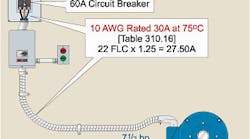To prevent a motor from burning up, you must provide a means of protecting it from overcurrent (overload, short circuit, or ground fault). If you can remember not to confuse motor protection with circuit protection, you’ll eliminate a major point of confusion in motor calculations.
Fig. 1. Conductors for a single motor must have an ampacity of not less than 125% of the motor full-load current rating.
Looking at Figure 430.1 in the NEC will help you keep this distinction clear. Notice that it shows the requirements for motor overload protection in Part III and the requirements for short-circuit and ground-fault protection in Parts IV and V.
Table or nameplate? To determine the minimum ampacity of the motor supply conductors, you obviously need to know how much current the motor draws. But there are different types of current in motor applications (see Motor Current Basics on page 80). Which do you use — full-load current (FLC) or full-load amperes (FLA) — for your motor calculations?
Fig. 2. The highest rated motor is the 120V motor at 34 FLC. The other motor(s) in the group (phase) is the 10-hp 3-phase motor, as indicated by the shaded area.
The NEC does not permit the use of motor nameplate FLA to determine the conductor ampacity; the branch-circuit short-circuit, and ground-fault overcurrent device size; or the ampere rating of disconnecting switches [430.6(A)(1)]. But it must use the motor FLA to size separate motor overload protection in accordance with Part III of Art. 430 [430.6(A)(2)]. Note the following exceptions:
• If you’re calculating separate motor overload protection for torque motors, use the locked rotor current value on the nameplate [430.6(B)].
• If a variable-frequency drive controls the motor, use the maximum operating current that’s marked on the nameplate (motor or control). If that value isn’t on the nameplate, use 150% of the values found in the NEC tables [430.6(C)].
• High-torque motors (and those built to operate under 1,200 rpm) may have higher FLCs, and the FLC of a multispeed motor varies with its speed. For such motors, use the nameplate current ratings [430.6(A)(1)].
• For a listed motor-operated appliance, use the FLC marked on the nameplate of the appliance (rather than the horsepower rating) to determine the ampacity (or rating) of the disconnecting means, branch-circuit conductors, controller, and branch-circuit short-circuit and ground-fault protection [430.6(A)(1) Ex 3].
Overload protection. Overload protection must comply with 430 Part III. Size overload protection devices based on the motor nameplate rating (this protects locked-rotor current damage to motor windings) [430.31].
Fig. 4. Branch-circuit conductors are protected against overloads by the overload device.
You can use a single overcurrent device, sized per 430.32 requirements, to protect a motor from overload, short circuit, and ground faults.
Branch-circuit conductor size. Branch-circuit conductors to a single motor must have an ampacity of not less than 125% of the FLC as listed in Tables 430.247 through 430.250 [430.6(A)(1), 430.22(A)].
When selecting motor current from one of these tables, note that the last sentence above each table allows you to use the ampacity columns for a range of system voltages without any adjustment. Select the conductor size from Table 310.16 according to the terminal temperature rating (60ºC or 75ºC) of the equipment [110.14(C)].
THHN/THWN is a common conductor insulation type that can be used in a dry location at the THHN 90ºC ampacity, or in a wet location at the 75ºC ampacity for the THWN insulation type. Regardless of the conductor insulation type, size the conductor per 110.14(C).
In 110.14(C)(1)(a), we read that equipment terminals are rated 60ºC for equipment rated 100A or less (unless marked 75ºC). Today, most equipment terminals are rated at 75ºC. Look for that specification, so you can use the 75ºC column if your conductors are also rated for 75ºC. If this is the case, you may save considerable money on your project. If you can’t find that specification, use the rules of 110.14(C).
Test your knowledge by answering this question: What size branch-circuit conductors are required for a 7½-hp, 3-phase, 230V motor (Fig. 1 on page 76)?
The motor FLC from Table 430.248 is 22A. The conductor is sized no less than 125% of motor FLC: 22A 3 1.25 = 27.50A. As per Table 310.16, a 10 AWG conductor is rated 30A at 75ºC.
The minimum size conductor permitted for building wiring is 14 AWG [310.5]; however, some local codes and many industrial facilities require branch-circuit conductors to be 12 AWG or larger.
Feeder conductor size. Perform feeder conductor size calculations the same way as for branch circuits, but use the different ampacity rules provided in 430.24. Conductors that supply several motors must have an ampacity of not less than:
(1) 125% of the highest rated motor FLC [430.17], plus
(2) The sum of the FLCs of the other motors (on the same line). Find the FLC in the NEC Tables [430.6(A)(1)].
The highest rated motor is the motor with the highest FLC [430.17]. Determine the “other motors in the group” value by balancing the motor FLCs on the feeder being sized, then select the line that has the highest rated motor on it (Fig. 2 on page 78).
Branch-circuit short-circuit and ground-fault protection. Each motor branch circuit must be protected against short circuit and ground faults by an overcurrent device sized no greater than the percentages listed in Table 430.52. The motor branch-circuit short-circuit and ground-fault protective device must be capable of carrying the motor’s starting current, and it must comply with 430.52(B) and 430.52(C).
A branch-circuit short-circuit and ground-fault protective device protects the motor, the motor control apparatus, and the conductors against short circuits or ground faults, but not against overload [430.51] (Fig. 3 on page 78).
It bothers many electrical practitioners to see a 14 AWG conductor protected by a 30A circuit breaker, but branch-circuit conductors are protected against overloads by the overload device (Fig. 4). That device is sized between 115% and 125% of the motor nameplate current rating [430.32]. See 240.4(G) for details.
Where the branch-circuit motor short-circuit and ground-fault protective device values derived from Table 430.52 don’t correspond with the standard overcurrent device ratings listed in 240.6(A), you can use the next higher overcurrent device rating. The “next size up protection” rule for branch circuits [430.52(C)(1) Ex 1] doesn’t apply to the motor feeder overcurrent device rating (Part II).
Keeping it straight. Articles 430 and 250 are the largest of the NEC Articles, and arguably the most misapplied. Something else these two Articles have in common but not with the other Articles is a “Figure 1” you can use as a guide.
In the case of Art. 430, this figure is a simple representation of the motor system with the correct Part of Art. 430 noted for each area of application. At the beginning of this article, we said that using Figure 430.1 will help you to not confuse motor protection with circuit protection when in actuality it can do much more. Spend some time working with it, and you’ll see how useful it really is.
If you base each motor project on Figure 430.1, you will reduce — if not eliminate — Art. 430 application errors.
Sidebar: Other Functions of MV Power Cable Shielding
Nameplate rating. The full-load amperes (FLA) is the current the motor draws while producing its rated horsepower load at its rated voltage.
NEC Tables. The full-load current (FLC) is the current value listed in Tables 450.247 through 450.250.
The actual current drawn by the motor depends upon the driven load and on the operating voltage at the motor terminals. If the load increases, the current also increases. If the motor operates at a voltage below its nameplate rating, the operating current will increase. It’s helpful to also understand:
• Motor-starting current. When voltage is first applied to the field winding of an induction motor, only the conductor resistance opposes the flow of current through the motor winding. Because the conductor resistance is so low, the motor will have a very large inrush current (see Figure above).
• Motor-running current. Once the rotor begins turning, there is an increase in counter-electromotive force that increases the impedance and thus reduces the current from the starting amperage to running amperage.
• Motor locked-rotor current. If the rotating part of the motor winding becomes jammed so it can’t rotate, no counter-electromotive force will be produced in the motor winding. This results in a decrease in conductor impedance to the point that it’s effectively a short circuit. What’s the result? The motor operates at locked-rotor current, often six times the full-load ampere rating, depending on the motor Code Letter rating [430.7(B)]. This will cause the motor winding to overheat and be destroyed if the current isn’t quickly reduced or removed.




